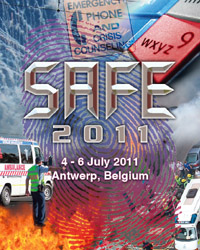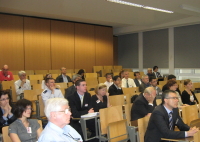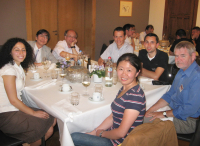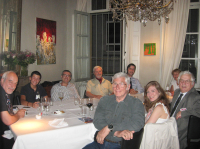SAFE 2011
4th International Conference on Safety and Security Engineering
4 - 6 July 2011
Antwerp, Belgium
Overview and Opening Addresses
 The fourth International Conference on Safety and Security Engineering has recently been held at the University of Antwerp, organised by the University of Rome ‘La Sapienza’ represented by Professors Massimo Guarascio and Fabio Garzia; the University of Antwerp, represented by Professor Genserik Reniers and the Wessex Institute of Technology, represented by Professor Carlos Brebbia.
The fourth International Conference on Safety and Security Engineering has recently been held at the University of Antwerp, organised by the University of Rome ‘La Sapienza’ represented by Professors Massimo Guarascio and Fabio Garzia; the University of Antwerp, represented by Professor Genserik Reniers and the Wessex Institute of Technology, represented by Professor Carlos Brebbia.
The meeting was opened by Professor Guarascio who refered to the history of the conference, started at the University of Rome ‘La Sapienza’ eight years ago and its unique character i.e. the combination of safety and security, a very interdisciplinary area of research. This conference – Professor Guarascio explained - is important in bringing together scientists from very different fields. The future of this important area of research rests in enlarging the fields of applications. Professor Guarascio also mentioned that the conference itself has resulted in the new International Journal of Safety and Security Engineering as a focus for research in this area.
Safety and security engineering, due to its special nature, represents an interdisciplinary area of research and applications that brings together, in a systematic way, many disciplines of engineering, from the most traditional to the most advanced and modern. It analyses the hazard context not only by means of traditional tools, but also by means of risk analysis techniques and the application of technical solutions, installations, systems, human resources and procedures to events, both natural and man-made that could damage people and property.
This implies that Safety and Security Engineering uses a systematic and multidisciplinary approach to decomposing the problems that need to be solved into elementary problems, studying their reciprocal relationships and interactions and finding a final optimum solution that takes into consideration all the multiple aspects, including those belonging to a complex system.
The purpose of SAFE 2011 was to continue to provide a forum for the presentation and discussion of the most recent developments in the theoretical and practical aspects of safety and security engineering.
Professor Carlos Brebbia then welcomed the delegates in the name of the Wessex Institute, expressing the gratitude of the conference to the University of Antwerp, which provided excellent facilities for the meeting. One of the motivations for choosing this venue is to highlight the research carried out by Professor Genserik Reniers’ group as well as to give the participants an opportunity to see the many developments that have taken place in Antwerp in the last few years. The city is now one of the most beautiful in Europe, with a long history and traditions, as well as a vibrant economy. Substantial developments have taken place in Antwerp and its cultural importance continues to grow. Professor Brebbia also referred to the importance of the conference for his Institute, which focuses on interdisciplinary research and dissemination of knowledge. The Institute carries out a series of research activities in their New Forest National Park location, including PhD training, participation in international projects and services to industry. Its programme of industrial research is particularly active serving aerospace, offshore and civil engineering amongst others. The Wessex Institute is renown for its development of advanced computational methods, and is recognised as the birthplace of boundary elements. This technique, which is now widely spread around the world, has been applied to many problems in fields other than classical engineering.
Professor Brebbia also referred to the importance of the conference for his Institute, which focuses on interdisciplinary research and dissemination of knowledge. The Institute carries out a series of research activities in their New Forest National Park location, including PhD training, participation in international projects and services to industry. Its programme of industrial research is particularly active serving aerospace, offshore and civil engineering amongst others. The Wessex Institute is renown for its development of advanced computational methods, and is recognised as the birthplace of boundary elements. This technique, which is now widely spread around the world, has been applied to many problems in fields other than classical engineering.
Publishing is another important activity of WIT, including a substantial number of books every year as well as four Journals. The books are widely distributed around the world in digital and paper format, and all conference papers are archived in the Institute’s eLibrary. This gives maximum dissemination to the work presented at WIT conferences. This – in Professor Brebbia's opinion – is most important for conference papers which ought to be properly recorded in order for original research to receive the recognition that it deserves. It takes time to publish in a Journal, conferences instead are most important as they are the first medium where new ideas are presented to the community.
The Institute also publishes three new Journals, which are open access and cater for extended versions of the papers presented at WIT Conferences. These papers reinforce the objectives of the research presented at the meetings, while being of a different character and subjected to a more careful review process.
Professor Brebbia ended by thanking all the authors for the quality of their papers and invited them to visit the WIT campus in the near future. They will always be welcome and wherever possible offered accommodation on campus.
Conference Sessions
The conferences sessions dealt with a series of important topics;
- Infrastructure protection
- Risk analysis, assessment and management
- Public safety and security
- Modelling and experiments
- Construction safety and security
- Transportation and road safety
- Safety of users in road evacuation
- Emergency and disaster management
- Process safety and security
- Emerging issues in safety
Invited Presentations
There were a series of invited presentations to enhance the meeting;
‘The target reliability and design working life’
M. Holický, Klokner Institute, Czech Technical University, Prague
‘High temperatures in parallel or perpendicular wood grain direction: a numerical and experimental study’
E. M. M. Fonseca, Polytechnic Institute of Braganca, Portugal
‘Collecting, archiving, and utilizing critical infrastructure information’
S. Conway, Urban Environmental Research, USA
‘Security of multimodal dangerous freight transport: the way forward’
G. L. L. Reniers, University of Antwerp, Belgium
‘The integrated security system of the Senate of the Italian Republic’
F. Garzia, University of Rome ‘La Sapienza’, Italy
‘Modeling safety and security, state of the art’
F. A. Maestas, Applied Research Associates, USA
‘Probabilistic and fuzzy fault-tree analyses for modelling cave-in accidents’
H. M. Al-Humaidi, Kuwait University, Kuwait
‘Economic analysis of safety risks in construction’
F. M. Almeida Santos, Tabique Engenharia Lda, Portugal
Excursions and Conference Dinner
 The conference offered the delegates plenty of opportunities to interact and get to know each other better. This took place during the coffee breaks, the complimentary lunches, conference dinner and specially-organised excursion at the end of the meeting.
The conference offered the delegates plenty of opportunities to interact and get to know each other better. This took place during the coffee breaks, the complimentary lunches, conference dinner and specially-organised excursion at the end of the meeting.
All the delegates and their partners were invited to participate in the Harbour Cruise. The Port of Antwerp is the second largest port in Europe and amongst the top ten in the world. It has been a source of wealth for the city over centuries and nowadays is very productive and profitable. The current port is located north of the city centre and covers about 13,500 hectares. It accommodates large ocean going ships and pleasure cruisers. It has many docks and drawbridges and around the clock activity. Anyone who has seen the port can see why Antwerp has been called a metropolis throughout the centuries. The Harbour Cruise took the delegates through several docks including the Delwaid dock where the large ships are anchored. The excellent weather and friendly environment helped to make this a special occasion.
The conference dinner took place in the University Club which is located in a beautiful XVI Century building. The excellent company, together with an outstanding menu and good wines, added to the enjoyment of the occasion. The delegates were able to experience a series of special dishes, starting with a cold soup consisting of a bed of carrot and paprika with avocado at the centre, followed by salmon accompanied by a variety of vegetables and ending with a unique combination of ice cream and pannacotta. Professor Brebbia proposed a toast to the conference and all participants, and expressed the gratitude of the organisers for the presence of delegates from so many different countries.
International Scientific Advisory Committee
 The International Scientific Advisory Committee met over dinner to discuss how the conference had progressed and when and where to reconvene it. The meeting took place in an excellent Flemish cuisine restaurant offering a series of local specialities. The general idea is to find ways to improve the conference and to decide if there is a case for holding it annually in view of the importance of the topic. The performance of the International Journal of Safety and Security Engineering was also discussed with a view of increasing its impact within the scientific community.
The International Scientific Advisory Committee met over dinner to discuss how the conference had progressed and when and where to reconvene it. The meeting took place in an excellent Flemish cuisine restaurant offering a series of local specialities. The general idea is to find ways to improve the conference and to decide if there is a case for holding it annually in view of the importance of the topic. The performance of the International Journal of Safety and Security Engineering was also discussed with a view of increasing its impact within the scientific community.
The success of the conference will ensure it being reconvened in 2013 in a place and a date to be decided shortly.
Publication of Papers
The proceedings of Safety and Security Engineering, 544pp (Print ISBN: 978-1-84564-522-9; Online ISSN: 1746-4498) are available in paper and digital format from WIT Press priced at £234/US$468/€328. Orders can be placed on the WIT Press web site at www.witpress.com or by email: This email address is being protected from spambots. You need JavaScript enabled to view it., telephone: +44 (0) 238 029 3223 or fax: +44 (0) 238 029 2853.
Papers from the conference will also be hosted online at the WIT eLibrary as Volume 117 of WIT Transactions on the Built Environment (Online ISSN: 1746-4498). For more details visit the WIT eLibrary at http://library.witpress.com

 Wessex Institute
Wessex Institute